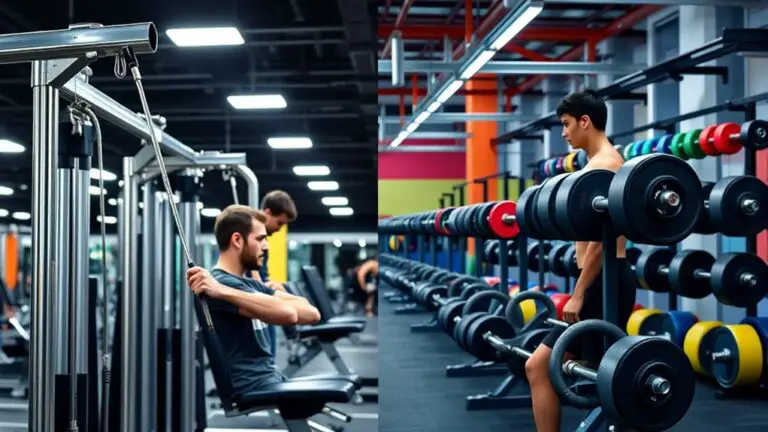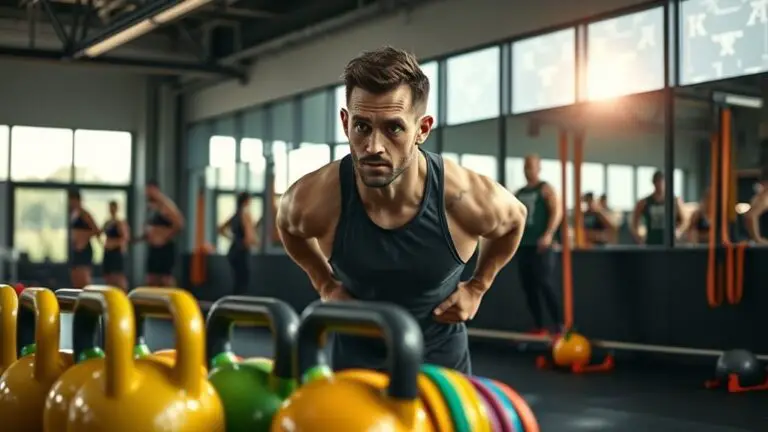How to Incorporate Powerlifting Into Your Gym Routine
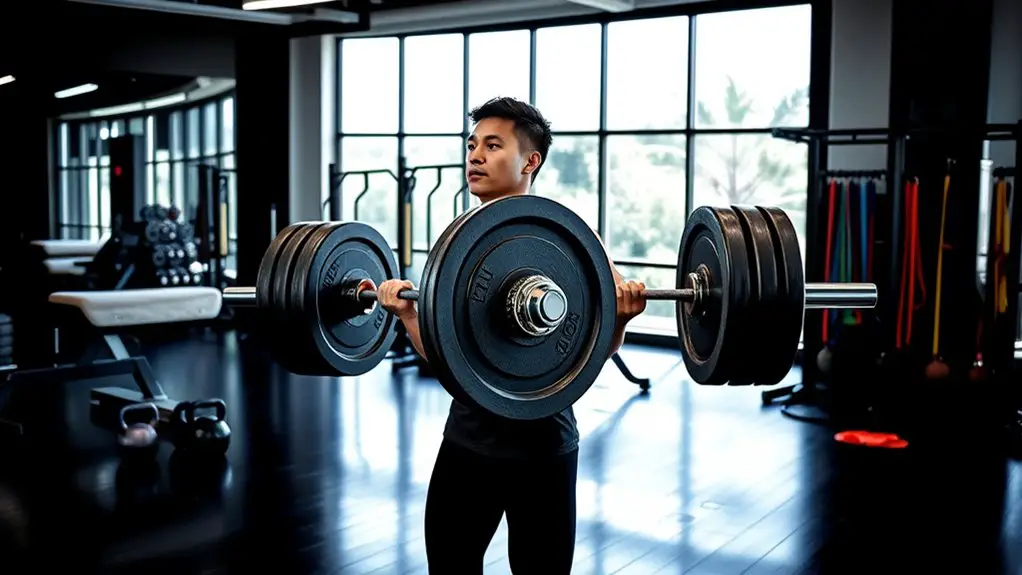
To incorporate powerlifting into your gym routine, start by mastering the three main lifts: squat, bench press, and deadlift. Assess your current strength and set realistic goals based on your capabilities. Develop a balanced workout schedule, aiming for three to four sessions per week, with rest days for recovery. Focus on proper technique and consider accessory exercises to build overall strength. If you’re keen to optimize your training, there’s more to explore about techniques and strategies.
Understanding the Basics of Powerlifting
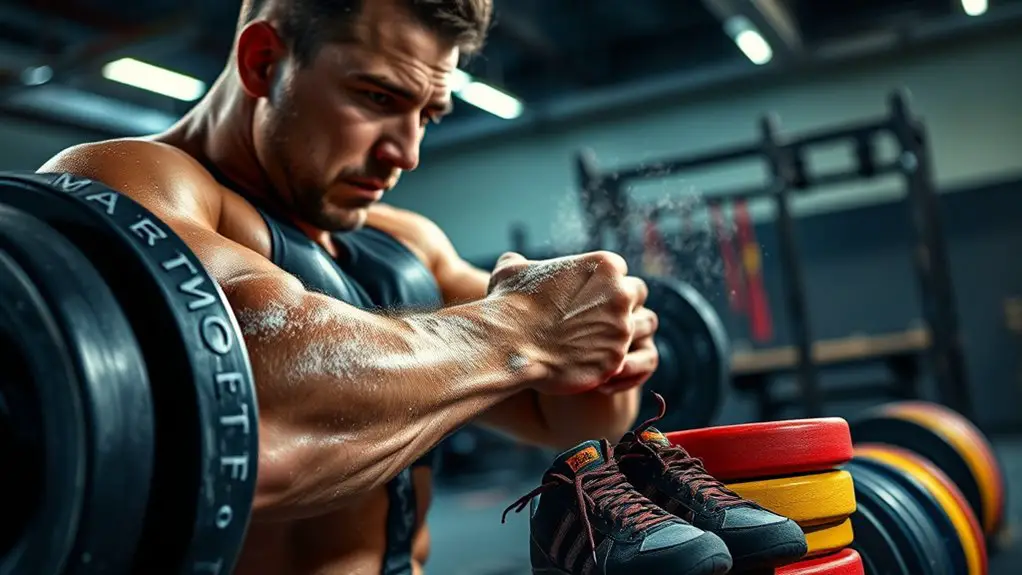
When you immerse yourself in powerlifting, it’s crucial to grasp its core principles. Understanding powerlifting history helps you appreciate the sport’s evolution and its competitive nature. Powerlifting focuses on three main lifts: the squat, bench press, and deadlift. Each lift has specific competition rules that guarantee safety and fairness, like proper form and weight class regulations.
Before you step onto the platform, familiarize yourself with these rules to avoid injuries and disqualifications. Safety should always be your priority, so consider working with a coach or experienced lifter to guide you on correct techniques.
Start with lighter weights to practice your form, making sure your body adapts safely. This foundation not only builds strength but also prepares you for future challenges. Embracing these basics will set you on a path to effective and safe powerlifting, enhancing your gym routine considerably.
Assessing Your Current Fitness Level
Before you plunge into powerlifting, it’s essential to evaluate your current fitness level to guarantee you’re starting on the right foot. A thorough fitness assessment can help you identify your strengths and areas for improvement. Begin by evaluating your current strength through a strength evaluation, which often includes exercises like squats, deadlifts, and bench presses.
Consider how many repetitions you can perform at a comfortable weight. This will give you a baseline to work from. Don’t forget to assess your overall fitness, including flexibility, endurance, and body composition.
Using this information, you can make informed decisions about your training approach. Remember, safety should always be your priority, so don’t hesitate to consult a fitness professional for guidance. By understanding your current fitness level, you’ll be better equipped to progress safely and effectively in your powerlifting journey.
Setting Realistic Goals for Powerlifting
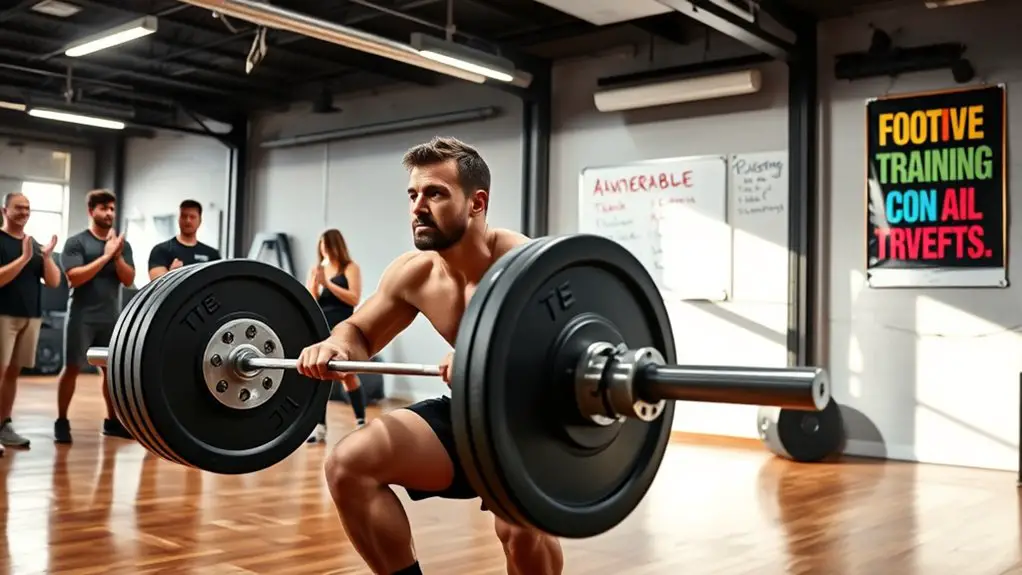
Understanding your current fitness level lays a solid foundation for setting realistic goals in powerlifting. Start by identifying your strengths and weaknesses, which will help you create achievable targets. Use goal setting to break down your objectives into smaller, manageable milestones. For example, instead of aiming to lift a specific weight immediately, focus on increasing your lifts gradually.
Incorporate motivation strategies, like tracking your progress and celebrating small victories, to keep you engaged. Remember, it’s essential to prioritize safety; avoid pushing yourself too hard too quickly. Listen to your body and adjust your goals as needed.
Consider setting timeframes for your goals, such as aiming to improve your squat by a certain percentage over three months. This structured approach not only enhances your performance but also builds confidence in your abilities. By setting realistic goals, you’ll find powerlifting rewarding and sustainable in the long run.
Developing a Balanced Workout Schedule
To develop a balanced workout schedule for powerlifting, you’ll want to guarantee that you’re giving equal attention to all major muscle groups while incorporating adequate rest. Aim for a workout frequency of three to four sessions per week, allowing for recovery between intense lifting days. For instance, you could alternate between upper and lower body workouts, ensuring that each muscle group gets targeted effectively.
Incorporating rest days is essential for muscle recovery and growth. Listen to your body; if you feel fatigued or sore, don’t hesitate to take an extra day off. It’s better to rest than risk injury. Additionally, consider including lighter, active recovery sessions focused on mobility or flexibility. This approach not only helps to improve your lifting performance but also keeps your workouts safe and sustainable. Remember, consistency and rest are key components in developing strength and avoiding burnout.
Mastering the Technique of the Three Main Lifts
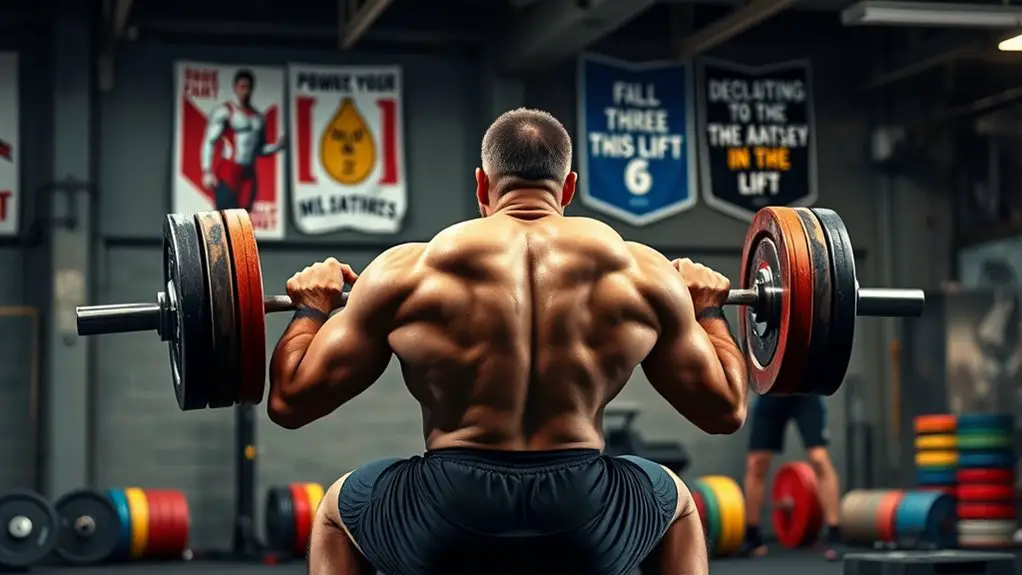
Although many lifters focus on building strength, mastering the technique of the three main lifts—squat, bench press, and deadlift—is essential for long-term success and injury prevention. Proper technique not only maximizes your performance but also minimizes the risk of injury. Here are some key points to take into account:
Mastering the technique of squat, bench press, and deadlift is crucial for success and injury prevention in lifting.
- Focus on form: Prioritize correct posture and movement patterns over lifting heavier weights.
- Incorporate lift variations: Use variations like box squats or paused bench presses to target weaknesses and improve overall technique.
- Practice technique drills: Spend time on drills that enhance your lifting mechanics, such as tempo squats or deadlift pauses.
Incorporating Accessory Exercises for Strength
Accessory exercises are key to enhancing your overall strength in powerlifting. By incorporating targeted movements, you can improve your performance on the main lifts while also addressing any weaknesses. Let’s explore some effective accessory movements that can elevate your training routine.
Importance of Accessory Exercises
While powerlifting focuses on the big three lifts—squat, bench press, and deadlift—incorporating accessory exercises is essential for building overall strength and preventing injuries. These exercises help target muscle imbalances, enhance your performance, and improve your lifting technique. Here are some accessory benefits you’ll gain:
- Improved stability for better lift execution
- Muscle hypertrophy to support your main lifts
- Injury prevention through balanced muscle development
Recommended Accessory Movements
Many lifters underestimate the value of accessory movements, but they play an essential role in enhancing your overall strength and performance. Incorporating exercises like Romanian deadlifts, lunges, and bent-over rows can greatly improve your strength training regimen. These movements target specific muscle groups, helping to build muscle endurance and prevent injuries.
Additionally, consider including core exercises like planks and hanging leg raises, as a strong core supports all major lifts. Always prioritize proper form and start with lighter weights to guarantee safety as you progress. By integrating these accessory movements into your routine, you’ll not only boost your powerlifting performance but also promote balanced muscle development, making your workouts more effective and safer.
Tracking Progress and Making Adjustments
Tracking your progress in powerlifting is essential for making informed adjustments to your routine. By regularly monitoring your lifts, you can identify strengths and weaknesses, ensuring a safer and more effective training experience. Here are some key progress tracking and adjustment strategies to contemplate:
Regularly tracking your powerlifting progress helps you identify strengths and weaknesses for a safer, more effective training experience.
- Log Your Workouts: Record weights, sets, and reps to spot trends over time.
- Set Specific Goals: Establish short-term and long-term targets to keep motivation high and focus sharp.
- Listen to Your Body: Pay attention to signs of fatigue or discomfort, and adjust accordingly to prevent injury.
Frequently Asked Questions
Can Beginners Start Powerlifting Without Prior Weightlifting Experience?
Absolutely, you can start powerlifting as a beginner! By focusing on beginner techniques, you’ll build foundational strength safely and effectively. Start with lighter weights to guarantee proper form, gradually increasing your load as you gain confidence. Prioritize your body’s signals; if something feels off, don’t hesitate to adjust. With patience and consistency, you’ll develop strength and skills necessary for powerlifting while minimizing the risk of injury. So, get started and enjoy the journey!
How Often Should I Compete in Powerlifting Meets?
When deciding how often you should compete in powerlifting meets, it’s essential to balance competition frequency with adequate meet preparation. For most lifters, competing three to four times a year is a good starting point. This allows you to focus on training, recovery, and improving your technique while minimizing the risk of injury. Listen to your body, and make certain you’re well-prepared before each meet to perform safely and effectively.
What Nutrition Plan Supports Powerlifting Training?
To support your powerlifting training, you need a solid nutrition plan. Focus on high-quality protein sources like chicken, fish, and legumes to aid muscle recovery. Meal timing’s essential; try to eat a balanced meal with carbs and protein about an hour before your workouts to fuel your lifts. After training, have a post-workout meal to replenish energy and support muscle growth. Staying hydrated is important, too—don’t forget to drink plenty of water!
Is Powerlifting Suitable for Older Adults?
Powerlifting isn’t just for the young and mighty; it can be a transformative experience for older adults! With proper age considerations and a focus on safety, you can reap incredible strength benefits. You’ll build muscle, improve bone density, and enhance overall health. Just make sure to consult a healthcare professional and possibly work with a trainer to tailor your approach. It’s never too late to release your inner powerhouse!
How Do I Prevent Injuries While Powerlifting?
To prevent injuries while powerlifting, focus on injury prevention through proper form. Always start with lighter weights to master the techniques before progressing. Pay attention to your body; if something feels off, don’t push through the pain. Incorporate warm-ups and cooldowns, and consider working with a coach to refine your form. Finally, guarantee you’re allowing your muscles adequate recovery time to reduce the risk of injury and promote overall strength gains.



